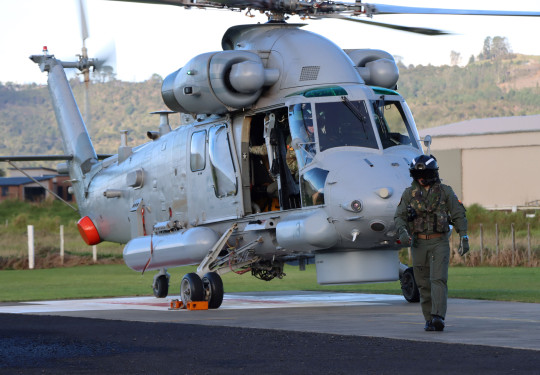Coromandel terrain provides invaluable training for maritime helicopter crew
Whitianga locals had a bit of a different view last month, as a Royal New Zealand Navy Seasprite SH-2G(I) helicopter took to the skies over the Coromandel region.
12 July, 2023
The helicopter, along with the aircrew and maintenance team from No. 6 Squadron RNZAF, were based out of Whitianga Airfield and undertook mountain flying training in the area.
It was the first time Sub Lieutenant (SLT) Tom Usher was able to put his hand to mountain flying.
“It was really exciting to go into the mountains and try something different. We look after the tactical side of things, being a maritime warfare capable helicopter, so we’re usually based off the back of a ship. My primary role is the management of weapons and sensors in a tactical environment, so mountain flying is a smaller part of my role, but we need to train in different environments so we can respond when called upon, so it’s really invaluable,” says the 30-year-old Aucklander.
Commanding Officer No. 6 Squadron, Commander Alex Trotter, says the Coromandel provides very challenging terrain to fly around, especially with associated weather such as strong winds and low cloud.

Mountain flying in the Coromandel
“The Coromandel is an excellent representation of the type of South Pacific environment that we are expected to operate in, with very similar terrain to places like the Solomon Islands, the Kermadecs and Sub-Antarctic island chains. It’s a mixture of very sharp relief with high ridges and pinnacles, leading into deep, forested valleys. This is very challenging terrain to fly around, so training our crews here sets them up for success when we ask them to conduct land-based operations,” says CDR Trotter.
SLT Usher was able to practice manoeuvres for the first time during the week-long training, including approaching pinnacles, ridgeline crossings, up-valley and down-valley approaches.
“We normally operate over water at about 400ft. This week we were getting up to 3,000 feet, but the real difference is the terrain, how to approach the terrain and the environmental conditions to consider, especially hitting one side to uplift and downwash the other side,”
~ SLT Usher
“The approach to a pinnacle is to simulate a winch manoeuvre, but it’s different from what we normally do as the pilot would usually have good references. It’s harder to judge how fast you’re approaching it out here,” he says.
SLT Usher was “on the beat’ as a Constable with the New Zealand Police in Invercargill, until joining the Navy in 2019 as a Bridge Watchkeeper. Most of his family were in the Royal Navy, but he’ll be the first to switch to naval aviation, something he’s always been interested in.



“I really enjoy the mental stimulation you get from the job. No two days are the same and there’s always problem-solving, there’s always more than one way to skin things. It’s about using the information to come to the best solution. I find it really rewarding and sets it aside from other jobs. It’s good fun,” he says.
The training was is part of his Operational Conversion Course, which resulted in him being able to fly unsupervised.
“I’ll finish my conversion course at sea on HMNZS Te Mana at Exercise Bersama Lima in Malaysia later this year, where we’ll be utilising anti-submarine warfare capability. As the observer, using tactical systems to search and destroy submarines is our bread and butter. So it’s really exciting to be finishing the course on this note,” he says.
